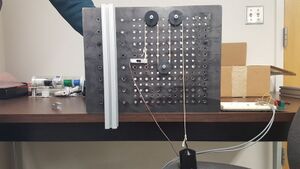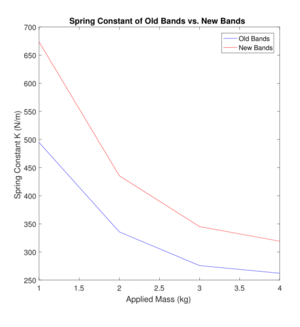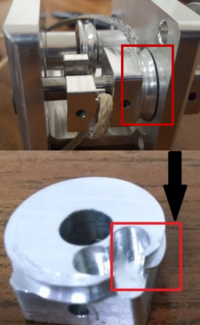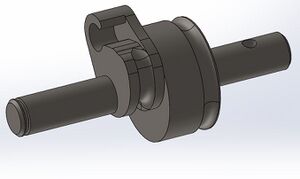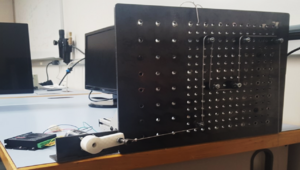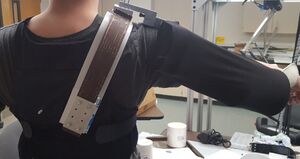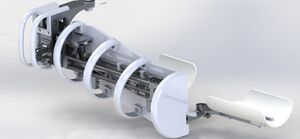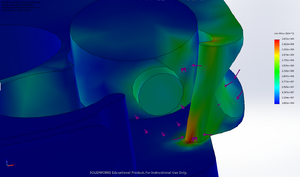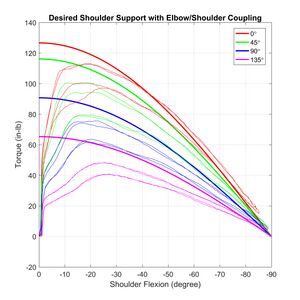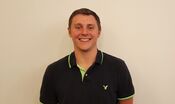Wearable Mobile Arm Support
| Arm Rehabilitation Mobile Support | |
|---|---|
| Sponsor: | University of Idaho |
| Team Name: | ARMS |
| Duration: | Fall 2016 - Spring 2017 |
| Faculty Advisor: | |
| Mentor: |
|
| Students: | |
The goal of this project is to improve upon the current arm support device by making it portable, reducing friction, improving force mapping, and making it safe. This was achieved by creating a portable model, testing pulley friction, continuous device testing, and redesigning cams within the system.
Problem Definition
Background
Patients with neurological damage to the brain from events such as stroke often exhibit a loss in arm range of motion on the contralateral side of the body. It has been shown that by simulating a low-gravity environment, through gravitational support to the arm, a patient can achieve a larger range of motion. This increased range of motion may be sufficient to allow the completion of otherwise unattainable movements and tasks such as functional ADLs (activities of daily living) or tasks that are beneficial to promote further recovery of lost range of motion. The University of Idaho has designed an arm support that supports the arm and could allow stroke patients to regain lost function and mobility. Our objective is to understand its shortcomings, identify sources of error, and improve the system.
Design Constraints
- Device must
- Safe to the user
- Low friction to allow for close mapping of desired forces
- Wearable/Mobile
- Device should
- Be comfortable for extended use
- Sleek enough to avoid collisions with environment
- Wearable
- Able to put on and taken off in under 2 minutes
- Be aesthetically pleasing
- Improve elbow stability when the arm is extended
Project Learning
Pulley Board Trials |
Our initial test setup can be seen on the left. The objective of this test was to observe how different masses, numbers of pulleys, and types of cable effects friction. We also compared how different cable diameters and pulley diameters effect the system. While doing this test a mass was moved up and down by hand which lead to a high margin of error. |
Surgical Tubing Fatigue |
Preliminary tests were taken to allow for comparisons after modifications and to check for ongoing issues. These tests ended up showing us that the bands used to store energy were fatiguing over time. An image of the results can be seen to the left. We believe that the fatigue was mainly caused due to constant tension on the tubes and repeated use. To resolve this we replaced the tubing. |
Contact Points and Deformation |
Upon receiving the project we looked over the current model closely and found a contact point between a cam and the bracket as seen on the left. We removed material from the bracket, which in turn reduced the friction in the device. We also found that the cams within the internal elbow rotating assembly were deforming due to the high stresses within the system. We later redesigned the cams to eliminate this problem. |
Design
Shaft/Cams Redesign |
The original assembly consisted of individually machined aluminum cams fixed to a steel shaft. To increase the robustness and life of the internal elbow rotating assembly the shaft was redesigned and manufactured into one solid steel piece as seen on the left. Critical points on the cams were also redesigned to further increase the factor of safety within the assembly. We later performed a finite element analysis to confirm that we resolved the deformation issue. |
Pulley Board 2.0 |
The pulley board was redesigned to reduce the error that was prominent in the initial tests. A motor was used to move the mass rather than by hand which moved the mass at a more consistent velocity. This helped reduce the effects of inertia while testing and produced more accurate results. |
Wearable/Portable |
To make the Arm portable a vest was designed using a police tactical vest, thermoplastic, 3D printed parts, laser cut wood cross sections, several machined blocks of aluminum, therapeutic foam, and an assortment of fasteners bought from a local supply shop. The thermoplastic was first cut, then molded with a heat gun to fit the contours of the subjects back. 8 shoulder contours were laser cut from a piece of birch wood and secured to the thermoplastic via the machined metal blocks and the fasteners. The tactical vest was slipped under the thermoplastic and attached followed by the arm being attached at the top shoulder. |
Safety Cover |
A cover was designed to improve the devices aesthetics as well as providing safety for the user. The design is lightweight and uses several arches to support a nylon cover. This cover protects the user from a potential cable snap, pinch points, and sharp edges. |
Results
FEA Analysis |
To confirm adequate strength of the redesigned shaft before machining a finite element analysis was preformed using SolidWorks. Force values calculated for the cable tensions and end terminations were applied to the model to simulate the actual forces of the device, as seen on the left. The final shaft design accepted a safety factor of 2 at critical loading points. |
Force Mapping |
After modifications were made to the arm a final test of the shoulder forces was completed, results can be seen on the left. The thick lines represent the desired torques while the thin lines represent the actual values. As can be seen at most angle the values are still below the desired forces, but are closer than they had been all year. We believe this could be due to the friction within the system. However, our modifications did slightly lower the hysteresis within the system. |

